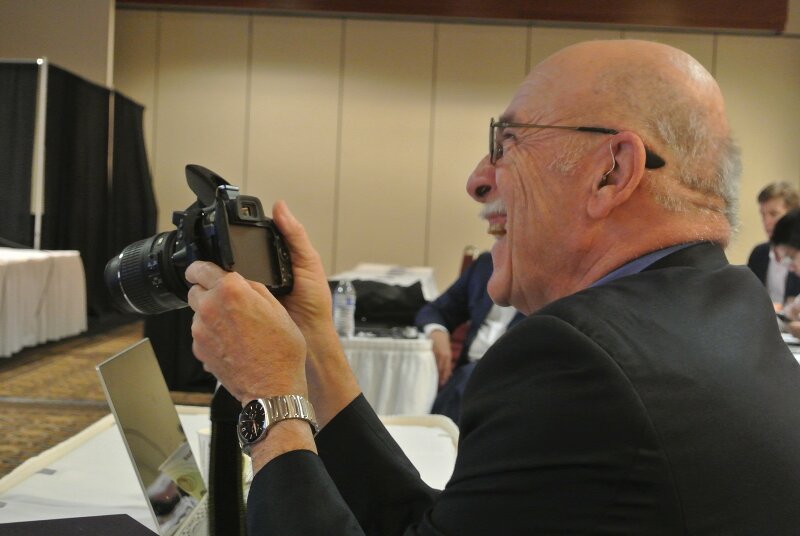The 2017 Vehicle Displays and Interfaces Symposium, held in Livonia, Michigan, on September 26 and 27, continued the growth, stimulating content, and enthusiasm demonstrated last year. Attendance this year was 550, compared to 400 last year and 300 the year before. Exhibit tables were up to 73 this year from 61 in 2016.
The first order of business was the bestowing of the “SID-MetroDetroit Chapter Award for Lifetime Contribution 2017” to Robert Donofrio. Donofrio was among those who created what was then the Vehicle Displays Conference, and he has nurtured it to this day.
 Robert Donofrio, one of the creators of the Vehicle Displays and Interfaces Symposium, received the “SID-MetroDetroit Chapter Award for Lifetime Contribution 2017.” (Photo: Ken Werner)
Robert Donofrio, one of the creators of the Vehicle Displays and Interfaces Symposium, received the “SID-MetroDetroit Chapter Award for Lifetime Contribution 2017.” (Photo: Ken Werner)
Thomas Seder (GM Technical Fellow and Chief Technologies — HMI at General Motors Research & Development) presented the opening keynote address.
Automotive Augmented Reality Systems Architecture, Supporting Tehnologies, and HMI Requirements.
 Seder define augmented reality (AR) within the context of Milgram’s “reality-virtuality” continuum, which includes reality, augmented reality, augmented virtuality (AV), and virtual reality (VR). Let’s focus on the first two. The reality display incorporates advanced display technologies, including OLED, free-form curved LCD, and head-up display (HUD), to support the tradtional human-maching interface (HMI) “with beautiful and highly usable display systems.”
Seder define augmented reality (AR) within the context of Milgram’s “reality-virtuality” continuum, which includes reality, augmented reality, augmented virtuality (AV), and virtual reality (VR). Let’s focus on the first two. The reality display incorporates advanced display technologies, including OLED, free-form curved LCD, and head-up display (HUD), to support the tradtional human-maching interface (HMI) “with beautiful and highly usable display systems.”
In contrast, the augmented reality HUD incorporates a HUD with a wide field of view (FOV) that can register virtual images by using a “plethora of sensors & apps.” The AR HUD “improves situation awareness, trust, and provides a ‘face’ to ADAS.”
Seder distinguished between annotated reality and augmented reality. In annotated reality, “virtual images are loosely registered and are presented on the real world to highlight artifacts (POIs). Information is added to the world, [which] clutters the visual scene.” With augmented reality, “virtual images are registered and overlaid onto important real world objects to enhance saliency. No information is added to the world, [so AR] does not clutter the visual scene (not really true).”
Seder presented an augmented reality functional block diagram that broke the AR HUD flow into three distinct processes. The first is Sense, with the sensing being done by vehicle sensors such as RADAR, LIDAR, GPS, DGPS, visible cameras, NVIS cameras, and a head-eye tracker.
The second process is to register the sensed information with the artificially generated images, using algorithms running on a dedicated AR processor with GPU. The processor aggregates sensor data, performs sensor fusion, and transforms the perspective of the sensors to that of the driver’s, thus enabling overlay and registration of AugRel images onto the real world. AugRel apps include highlighting of lane markings, targeting vehicles, and targeting pedestrians. And the system must include machine learning algorithms.
The final process is displaying the AugRel images, which requires “a wide FOV (field of view) HUD with performance attributes that supports the AR illusion.” The AR HUD has to “paint the road” with the AugRel images, Seder said. What does “wide FOV” mean? Seder referred to THX, which says that an FOV of greater than 40 degrees in needed for an immersive experience.
Seder noted “Even simple tasks baffle some.” (To which my wife Arlette, a noted technophobe, responded, “Simple is never simple.”)
The chief goal of AR, Seder said, is to improve situational awareness. As situations change, the user’s mental model of the world may lose its congruence with the current state of the world. Seder concluded by saying that a critical goal of AR is to maintain the congruence between the user’s mental model and the current state of the world. This is not at all simple, as other portions of Seder’s presentation made clear.
“HMI design will make or break these systems,” said Seder. “We really don’t have established AR format design requirements. Thus rigorous on-road testing of AR systems is essential to generate the missing core knowledge.”
This was a masterful presentation, and an essential introduction to vehicular augmented reality.

